《金融英语》课件1
- 格式:ppt
- 大小:570.50 KB
- 文档页数:151
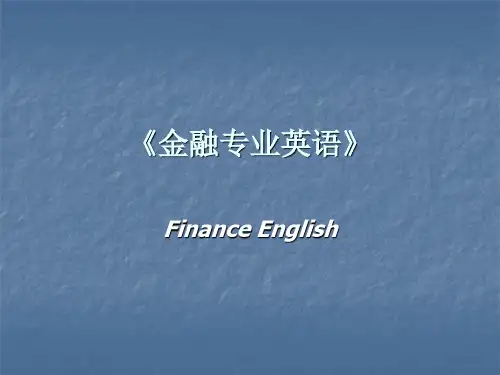

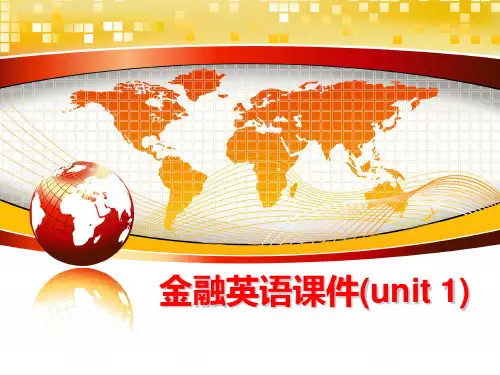
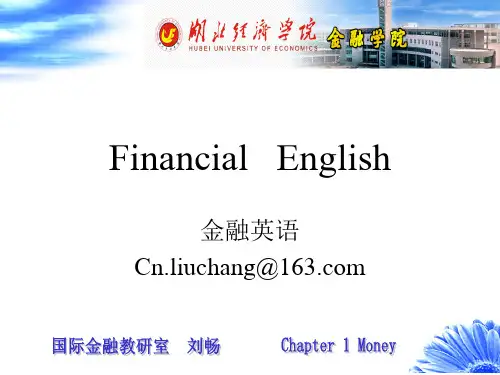
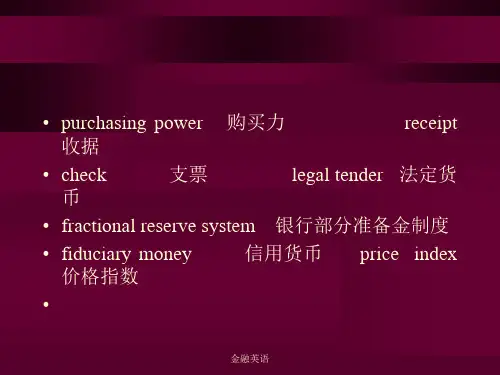
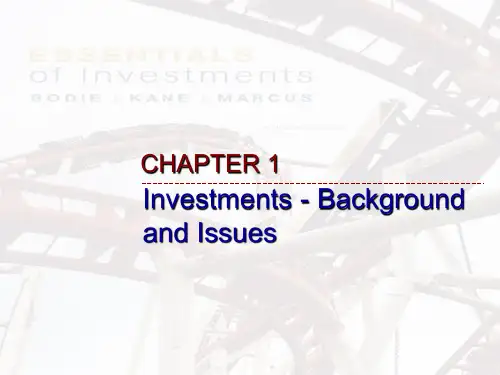

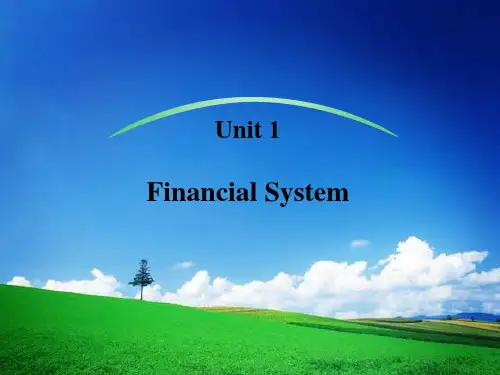

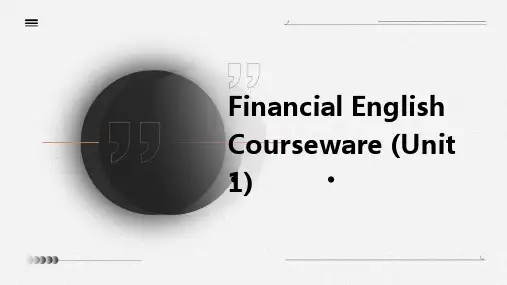
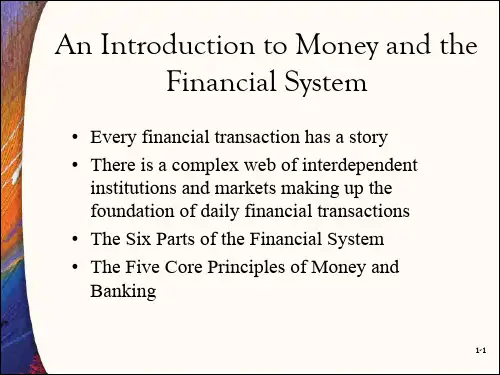
MoneyIf you can actually count your money, then you are notreally a rich man.——American oil billionaire J. Paul GettyWhat is moneyEconomists define money as anything that is generallyaccepted in payment for goods or services or in the repaymentof debts.Types of moneyA. Commodity moneyB. Convertible paper moneyC. Fiat money(or fiat currency):Usually paper money, is a type of currency whose only value is that a government made a fiat that the money i s a legal method of exchange.Unlike commodity money or representative money it is notbased in another commodity such as gold or silver and is notcovered by a special reserve.D. Private debt moneyE. Electronic moneyPrivate debt moneyA loan that the borrower promises to repay in currency ondemand. . IOU the checkable deposit at commercial banks andother financial institutions.Commercial notes(商业票据):Short-term, unsecured, discounted, and negotiable notes sold by one company t o another in order to satisfy immediate cash needs.Include: promissory note (期票,拮据) draft (汇票) check and so on.Electronic money: Electronic Check, Internet Payment System, Credit Card ServiceWhat does money doA. Medium of ExchangeIn almost all market transactions in our economy, money i n the form of currency or checks is a medium of exchange; it isused to pay for goods and services. The use of money a s a medium of exchange promotes economic efficiency by eliminating much of the time spent in exchanging goods and services.Terms: Transaction cost, Time value of moneyB. Unit of AccountThe second role of money is to provide a unit of account;that is, it is used to measure value in the economy. We m easure the value of goods and services in terms of money, just as we measure weight in terms of pounds or distance in terms of miles.Note: Fiat money has not only no particular value in use; itdoesn't even really have a value in exchange except that which is decreed that it would have.Terms: Good money, Bad moneyC. Store of ValueMoney also functions as a store of value: it is a repository of purchasing power over time. It is an asset. It 's something that we can use to store value away to be retrieved at a laterpoint in time. So we can not consume today, we can hold money instead - and transfer that consumption power to some pointin the future.Term: Hard currencyMeasuring Monetary Aggregates1. Measure as “money” only those assets that are most liquid, hence that function best as a medium of exchange.2. Include all financial assets in the measure of money, butweight them in proportion to their liquidity.1. M1 = Most Narrow Measure (Most Liquid)M1 = currency + traveler’s checks + demand d eposits + other checkable deposits2. M2 = M1 + Less Liquid AssetsM2 = M1 + small denomination time deposits + savings deposits+ money market deposit accounts + money market mutual fund shares3. M3 = M2 + Less Liquid AssetsMoney supplyThe revenue raised through the printing of money. When t he government prints money to finance expenditure, it increasesthe money supply. The increase in the money supply, in turn,causes inflation. Printing money to raise revenue is likeimposing an inflation tax.To expand the money supply:The Federal Reserve buys Treasury Bonds and pays for themwith new money.To reduce the money supply:The Federal Reserve sells Treasury Bonds and receives the existing dollars and then destroys them.InflationInflation is an increase in the average level of prices,and a price is the rate at which money is exchanged for a goodor service.Here is a great illustration of the power of inflation:In 1970, the New Y ork Times cost 15 cents, the median price of a single-family home was $23,400, and the average wage inmanufacturing was $ per hour. In 2008, the Times cost $, theprice of a home was $183,300, and the average wage was $ per hour.Hyperinflation is defined as inflation that exceeds 50percent per month, which is just over 1 percent a day.Questions1. Money is not unique as a store of value; any asset, beit money, stocks, bonds, land, houses, art, or jewelry, can be used to store wealth. Many such assets have advantages overmoney as a store of value: They often pay the owner a higherinterest rate than money, experience price appreciation, anddeliver services such as providing a roof over one's head. Ifthese assets are a more desirable store of value than money,why do people hold money at allThe answer to this question relates to the importanteconomic concept of liquidity.2. Rank the following assets from most liquid to leastliquid:a.Checking account depositsb. Housesc. Currencyd. Washing machinese. Savings depositsf. Commonstock3. Why have some economists described money during ahyperinflation as a “hot potato” that is quickly passed from one person to another4. Was money a better store of value in the United Statesin the 1950s than it was in the 1970s Why or why not In whichperiod would you have been more willing to hold money5. In Brazil, a country that was undergoing a rapidinflation before 1994, many transactions were conducted indollars rather than in Reals, the domestic currency. WhyQuiz1. Fiat money is:A. credit card chargesB. CoinsC. not convertible into precious metals.D. checks Answer: C2. Which of these is not a function of money in an economyA. Store of valueB. Medium ofexchangeC. Source of incomeD. Unit of accountAnswer:C3. Which of the following is not part of M1A. checking accountsB. traveler'schecksC. savings accountsD. currencyv1.0 可编辑可修改Answer:C4. If Mary deposits $100 of her currency in her checking account, then:A. M1 w ill increase by $100.B. M2 w ill fall by $100.C. M1 and M2 will not change.D. M2 will increase by$100.Answer:C5. If Mary moves $100 from her savings account to herchecking account, then:A. M1 will not change.B. M2 will not change.C. M1 will fall by $100.D. M2 will fall by $100. Answer:B6. Which of the following is not part of M2A. Small time depositsB. CurrencyC. Institutional money market mutual fundsD. SavingaccountsAnswer:C7. Inefficiencies that are created when using checks asmoney include:A. Checks can transfer funds slowly.B. There are too many bad checks written.C. Checkbooks can be stolen.D. Checks can be written for any amount.Answer:A8. The liquidity of an asset is:A. the ability of an asset to earn interest income.B. the amount of an asset sold at discount or premium.C. the relative ease with which an asset can be convertedinto a medium of exchange.D. the relative ease with which an asset can be convertedinto a common stock.Answer:C9. For a commodity to function effectively as money, it mustA. Be widely accepted.B. Be backed by gold orsilver.C. Be indestructible.D. Be printed by thegovernment.Answer:A10. Money supply data is generated by:A. The Department of CommerceB. The Federal Deposit Insurance Corporation (FDIC)C. The Federal Reserve System (the Fed)D. The Treasury DepartmentAnswer:C11. Which of the following correctly shows the evolutionof the payments systemA. Commodity money, fiat money, checks, electronic money.B. Commodity money, fiat money, electronic money, checks.C. Commodity money, checks, fiat money, electronic money.D. Fiat money, commodity money, checks, electronic money. Answer:A12.Which of the following is true regarding money's store of value functionA. money does not allow a person to hold purchasing powerfrom the time income is earned until it is spent.B. money is the only store of value available.C. money is the most liquid store of value available.D. money is superior to all other stores of value duringperiods of inflation.Answer:C13. Which of the following is not a disadvantage ofelectronic moneyA. People are concerned about the privacy and security ofe-money transactions.B. E-money transactions cost more than paper check transactions.C. The cost of setting up a system for processing e-money payments is high.D. E-money does not allow people to take advantage of float. Answer:B14. Wealth isA. Generally accepted for the repayment of debtsB. A flow of earnings per unit of timeC. A stock conceptD. The total collection of pieces of property that serveto store valueAnswer:D15. The Fed's measurements of monetary aggregatesA. Are more reliable in the short run than the long run.B. Are revised once a year.C. Does not depend on the definition of money.D. Are more reliable in the long run than the short run.Answer:D。